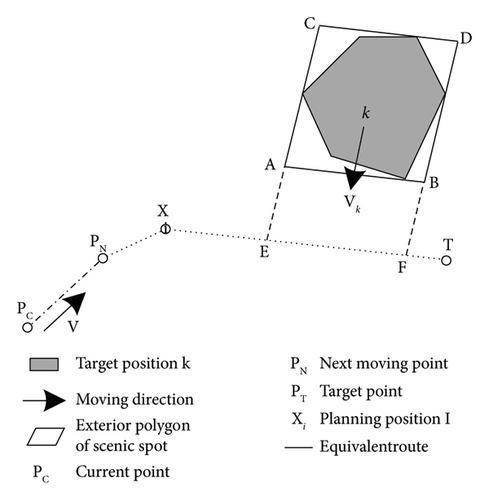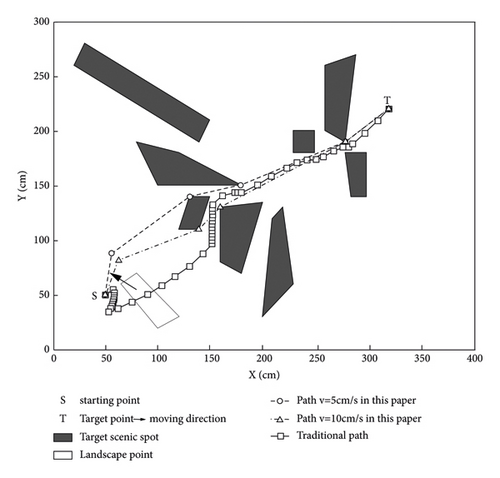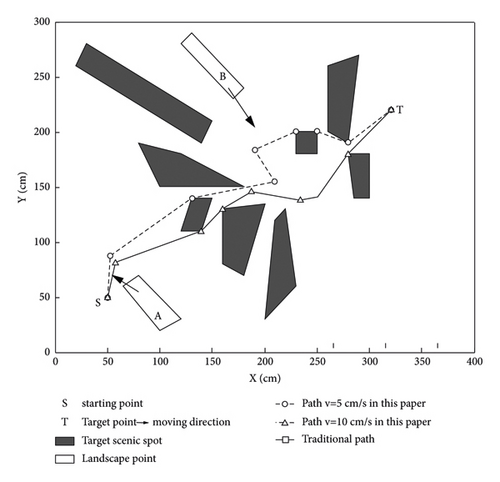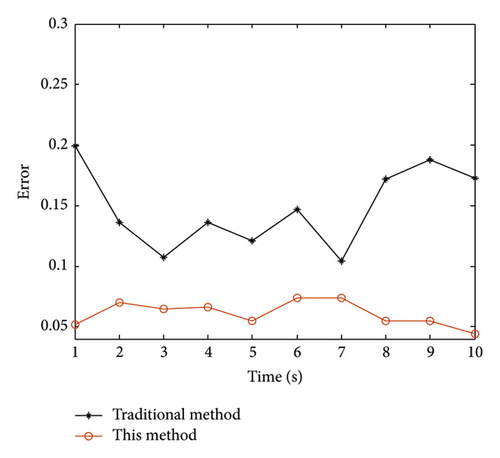A Real-Time Tourism Route Recommendation System Based on Multitime Scale Constraints
Abstract
In order to increase the capability of real-time intelligent recommendation of tourists’ information on cross-regional city-level tourist routes with epidemic normalization, a real-time intelligent recommendation algorithm for cross-regional city-level tourist routes with epidemic normalization based on multi-time scale constraints is proposed. Under the training of limited samples, the tourist correlation model of the epidemic normalization of cross-regional city-level tourist routes is created. In addition, two kernel functions i.e. the mixed and the global are assembled to excerpt the correspondence features of the epidemic normalization cross-regional city-level tourist route recommendation information. As a result, the well-known particle swarm optimization (PSO) procedure and algorithm with multitime scale constraints are adopted to carry out the adaptive learning of the epidemic normalization cross-regional city-level tourist route recommendation, and the convergence control of the recommended method is comprehended through mining the geographic information data sets of cities. This paper analyzes the universality and ergodicity of tourists′ personal interest preferences and social characteristics in urban tourism and combines a gradient algorithm to carry out particle swarm evolution and self-adaptive optimization for the recommendation of cross-regional city-level tourist routes with a normalized epidemic situation, so as to realize the group real-time intelligent recommendation of tourists’ information on cross-regional city-level tourist routes with the normalized epidemic situation. The model outcomes indicate that the exactitude and precision of cross-regional city-level tourism route information recommendation with this algorithm are decent, and the convergence of the swarm intelligence optimization (SIO) problem is robust, which can circumvent dipping into the local optimal solution in the process of real-time intelligent recommendation of tourism routes and improve the intelligence and global stability of cross-regional city-level tourism route recommendation with epidemic normalization.
1. Introduction
With the speedy improvement of the economy, the public′s corporeal standard has enriched obviously, and to a greater extent, people begin to pay attention to rich spiritual life, which promotes the development of tourism. However, under the background of epidemic normalization prevention and control, it brings great challenges to the tourism industry. At present, people mainly search for travel information on the Internet to customize their travel plans, but the information overload problem on the Internet is becoming more and more serious, so it is necessary to establish a model for recommending cross-regional city-level travel routes with epidemic normalization. Combining the distribution characteristics of cross-regional city-level travel routes with epidemic normalization, the reliability of recommending cross-regional city-level travel routes with network modeling big data cost analysis can be improved [1]. Therefore, to a greater extent, academics begin to recompense consideration to the exploration of travel route planning. Most tourists will be restricted by many factors such as traffic, expenses, time, scenic spots, and hotels. When making travel plans. However, the existing research does not fully consider tourists’ preferences and constraints, and it is difficult to really meet the individual needs of tourists [2].
The normalized cross-regional city-level tourist routes are realized by a personalized network of independent education and statistics facilities rendering to tourists′ personal predilections. Tourists’ statistics and knowledge resource information on the normalized cross-regional city-level tourist routes want to be boosted, categorized, and kept adaptively rendering to the tourists’ predilections [3]. The resource scheduling and personalized recommendation of the normalized cross-regional city-level tourist routes are combined with the multisource distributed design method to improve the resource scheduling ability of the normalized cross-regional city-level tourist routes and the ability to extract tourists’ urban tourism interests and preferences [1]. In the cross-regional city-level tourist routes with complex epidemic normalization, personalized recommendation and resource optimization scheduling are carried out for complex and diverse online learning resources rendering to the tourists’ past visit archives and predilections, so as to encourage the information practice and progress the energetic communication aptitude of the cross-regional city-level tourist routes with epidemic normalization [4]. It is of countless implications to revise the personalized real-time intellectual recommendation procedure of cross-regional city-level tourist routes with epidemic normalization in the optimization design of cross-regional city-level tourist routes with epidemic normalization. In the traditional methods, the personalized endorsement and communal detection approach for cross-regional city-level tourist routes with normalized epidemic situations mainly comprise intelligent PSO procedure, data clustering recommendation system, association rule-based mining process, and fuzzy PID recommendation procedure, etc., and the topological structure of cross-regional city-level tourist routes is optimized according to multilevel epidemic situation normalization [5].
Combining the appropriate features of the recommendation tasks and information sharing, a data clustering center for a personalized recommendation of epidemic normalization cross-regional city-level tourist routes is established, and an algorithm for a recommendation of epidemic normalization cross-regional city-level tourist routes is designed by using association rule mining method, so as to develop and progress the personalized appearance aptitude of epidemic normalization cross-regional city-level tourist routes. Related literature has designed the recommendation algorithm for epidemic normalization cross-regional city-level tourist routes, and achieved certain research results. Among them, in [6] it is proposed based on a community discovery algorithm of epidemic normalization cross-regional city-level tourist routes based on parallel recommendation, compelling the tourist manners value, tourist ingesting value, and faithfulness of the epidemic normalization cross-regional city-level tourist routes as independent variables. The fuzzy decision-making model for public detection of the epidemic normalization cross-regional city-level tourist routes is established, and the optimization design of the epidemic normalization cross-regional city-level tourist route recommendation model is carried out by combining the association mining method. Nevertheless, the calculation cost of this technique is enormous, and the real-time performance of the epidemic normalization cross-regional city-level tourist route recommendation is not good.
In [7], a community discovery and recommendation algorithm of epidemic normalization cross-regional city-level tourist routes founded on the transformation factor assessment and intellectual and adaptive PSO is proposed. The synchronization tag of epidemic normalization cross-regional city-level tourist routes communities is established, the community association attribute features of epidemic normalization cross-regional city-level tourist routes are extracted, and the association amongst the interaction degree within groups and recommendation consequence is investigated. To realize personalized recommendations of cross-regional city-level tourist routes for epidemic normalization, this method has poor intelligence in the process of recommending cross-regional city-level tourist routes for epidemic normalization, and its global optimization ability is not strong [8].
- (1)
We propose a real-time intelligent recommendation algorithm for cross-regional city-level tourist routes based on multitime scale constraints
- (2)
The tourist correlation model of the epidemic normalization cross-regional city-level tourist routes is assembled, and two kernel functions, i.e., the mixed and the global are created
- (3)
The particle swarm optimization algorithm with multitime scale constraints is adopted to carry out the adaptive learning of the epidemic normalization cross-regional city-level tourist route recommendation
The remaining manuscript is systemized in the subsequent fashion. In section 2, we discuss the tourism recommendation information model and correlation feature extraction. The recommended algorithm optimization process is deliberated in section 3. The simulation experiment and result analysis are validated in section 4. As a final point, section 5 recaps the manuscript and talks about promising future research.
2. Model for Tourism Recommendation and Extraction of Correlation Features
2.1. Recommended Information Transfer Model of Urban Tourist Routes
Wherein αi and are the recommended attribute values and template category numbers of cross-regional city-level tourist routes, respectively. In addition, the variable K(xi, xj) is a symmetric kernel function, in fact, sustaining the Mercer circumstance, and b represents the recommended threshold of cross-regional city-level tourist routes.
Wherein represents the fuzzy personalized feature distribution kernel function recommended by cross-regional city-level tourist routes, and represents the RBF kernel function of confidence trustworthiness of cross-regional city-level tourist routes with the normalized epidemic situation. In fact, its purpose is to adjust the impact of both kernel functions over the whole mixed kernel function, which is also known as, the weight coefficient. Therefore, an information transmission model for the recommendation of cross-regional city-level tourist routes with a normalized epidemic situation is constructed, and the tourist characteristics of cross-regional city-level tourist routes with a normalized epidemic situation are extracted and personalized recommendation design is carried out by combining the hybrid optimization method of particle swarm optimization [12].
2.2. Extraction of Correlation Features of Recommended Information of Tourist Routes
In the above formula, Ch(u) represents the association rule coefficient of cross-regional city-level tourism route recommendation, and node v is added to R2(u) in order to comprehend and understand the dynamic characteristic abstraction of personalized tourist features and characteristics [13].
3. Optimization of the Recommendation Algorithm
3.1. The Gradient PSO Procedure
Over the foundation of assembling a hybrid system which is in fact from the mixed and the global kernel function to excerpt the correlation features of the recommendation statistics of epidemic normalization cross-regional city-level tourist routes, an improved design of the real-time intelligent recommendation algorithm for epidemic normalization cross-regional city-level tourist routes is proposed in this paper. For the multiconstraint multiobjective tourist route planning problem, if only the objective function is weighted, the global optimal solution may not be obtained, so this paper practices the enhanced greedy set of rules to elucidate the optimal tourist routes. In the actual tourism scene, tourists are more thinking about which scenic spot is suitable to go next when the current scenic spot is finished. The greed algorithm is one of the most commonly used algorithms to solve the problem of route planning. However, in this paper, aiming at practical problems, an improved greedy algorithm is used to recommend the top M routes with the highest scores for tourists to choose [14].
3.2. Implementation of Real-Time Intelligent Recommendation Algorithm for Tourism Route
In the above formulas, t = 1,2, ⋯, T and T represent the maximum iteration times of the population. The convergence regulator of the recommended method is comprehended by mining the geographic information data set of the city. In order to show the system better, it is supposed that the tourist chooses the hotel scenic spot as shown in Figure 1, and the tourist stays in Hotel H, and the tourist expects to get the maximum tourism income. According to the above scenic spots A, B, C, and D, which route should he choose to play, he can get the maximum income while meeting the time constraint of tourists for 8 hours, and the cost constraint is 300 yuan. Assume that n = 2, that is, when the greedy algorithm is used, each scenic spot expands downwards into two scenic spots, and the number of routes with the highest revenue output, at last, does not exceed three. According to the threshold judgment result, whether the convergence criterion is satisfied or not is judged and appropriate decisions are made.

The particle swarm optimization and self-adaptive optimization are carried out for the recommendation of epidemic normalization cross-regional city-level tourist routes combined with a gradient algorithm [19]. The convergence regulator of the recommended procedure is comprehended by mining the city′s geographic information data set, and the universality and ergodicity of individual tourists′ urban tourism interests and social characteristics are investigated. In fact, the PSO and the process of self-adaptive optimization are carried out for epidemic normalization cross-regional city-level tourist routes combined with gradient algorithm, so as to comprehend the real-time intelligent recommendation of tourists′ information on epidemic normalization cross-regional city-level tourist routes [20].
4. Simulation Experiment, Results, and Discussion
In order to validate the accuracy and convergence of the anticipated technique in the real-time intelligent recommendation of cross-regional city-level tourist routes for the normalization of the epidemic situation, a simulation experiment was conducted. The system includes eight functional modules, including login and registration, the introduction of hotel attractions, preference constraint selection, tourist route planning, hotel information management, route, itinerary management, user information management, and scenic spot information management. Users who want to use the intelligent planning system for tourist routes must register first, and then they can log in after successful registration. After entering the system, users can first choose the information of the scenic spots they are interested in to browse [21]. Secondly, users can come to the preference constraint selection module, enter their own personalized constraints, including travel time, travel expense budget, and the conditions of favorite hotels and scenic spots, and submit them to the background server.
The server in the background will obtain the personalized constraints of users, recommend the hotels and scenic spots with the highest scores for users according to the model established above, and then plan a number of tourist routes for users to show to them with the maximum profit. Users can also manage their past itineraries anytime and anywhere. Administrators have the authority to add, delete and check the information of hotel and scenic spot users, the quantity of tourists that were verified is 2,000, the trial function of the PSO is assumed as type and combination of the ZDT series test functions, the amount of all particles in a particular particle group in D-dimensional universe is 20, the recommended simulation time is 1.3 s, and the iteration is carried out for 6,000 times. The mining results and findings of tourists’ urban tourism interest preferences on the cross-regional city-level tourist routes with a normalized epidemic situation are shown in Figure 2.

With the method of this paper, the real-time recommendation method of tourist routes based on multitime scale constraints is adopted, and the result of route optimization recommendation is shown in Figure 3.

Taking the results of route optimization and recommendation in Figure 3 as the input test sample set for tourists’ urban travel interest preference for the epidemic-normalized cross-regional city-level tourism route, the adaptive learning of the epidemic-normalized cross-regional city-level tourism route recommendation was performed, and the curve of the convergence was acquired as made known in Figure 4.

According to the analysis of Figure 4, the self-adaptive learning ability of real-time intelligent recommendation of epidemic normalization cross-regional city-level tourist routes by this method is strong, and the universality and ergodicity of urban tourism interest preference and feature mining of epidemic normalization cross-regional city-level tourist routes are good. Additional test the errors of dissimilar approaches in recommending cross-regional city-level tourist routes for epidemic normalization, and get the comparison results as given away in Figure 5. The examination of the results in Figure 5 displays that the accuracy of this method in recommending the information of cross-regional city-level tourist routes with epidemic normalization is decent, and the nondivergence of the swarm aptitude optimization is significantly robust so that the real-time intelligent recommendation process of cross-regional city-level tourist routes with epidemic normalization can be avoided from falling into a local optimal solution.

On this basis, the formulation of tourists’ travel plans first needs to determine the tourist attractions they want to visit and the hotels they stay in. Based on this, this paper sets up a hotel attraction scoring model, sets tourists’ preference design for hotels and attractions, integrates the information of related hotel attractions, and according to the preference information input by tourists, puts a good hotel and attractions for tourists to choose. In this way, there is no need for tourists’ past travel data, so there is a problem of “moving after a cold.” This paper also establishes a multi-constraint and multi-objective tourism route planning model. After tourists have determined their tourist attractions and hotels, the next problem they face is how to determine their tour order [22]. According to the actual needs of tourists, this paper puts forward a tourism route planning model, which sets the starting point and ending point of tourism to be hotels, practices the enhanced greedy procedure and set of rules to solve the model, and finally, obtains the most profitable tourism routes. The model fully considers the realistic factors and has certain rationality and usability.
5. Conclusions and Future Work
According to tourists’ historical visit records and preferences, personalized recommendations and resource optimization scheduling can be carried out to promote the information use of cross-regional city-level tourist routes with the normalized epidemic situation. This paper proposes a real-time intelligent recommendation algorithm for cross-regional city-level tourist routes with the normalized epidemic situation based on multitime scale constraints. Under the training of limited samples, the tourist correlation model of epidemic normalization cross-regional city-level tourist routes is constructed, and the correlation features of epidemic normalization cross-regional city-level tourist routes recommendation information are extracted. In addition, subsequently, the convergence governor of the recommended procedure is comprehended by mining the city′s geographic information data set, and the universality and ergodicity of tourists’ individual urban tourism interest preferences and social characteristics are examined. In fact, the particle swarm evolution and dynamic optimization of epidemic normalization cross-regional city-level tourist routes recommendation are performed by combining the gradient process, so as to comprehend the real-time intelligent endorsement of epidemic normalization cross-regional city-level tourist routes. The research shows that the accuracy of information recommendation of epidemic normalization cross-regional city-level tourist routes by the anticipated process is decent, and the antidivergence of the swarm intelligence optimization is significantly robust so that the real-time intelligent recommendation process of epidemic normalization cross-regional city-level tourist routes can be avoided from dwindling into local optimal solution, and the intelligence and global stability of epidemic normalization cross-regional city-level tourist routes recommendation are enhanced. In fact, this has virtuous application significance in a real-time intellectual recommendation, as well as, in the personalized learning of epidemic normalization cross-regional city-level tourist routes [15].
Conflicts of Interest
The authors declare that they have no conflicts of interest.
Acknowledgments
This study was supported by Research on the development trend and high-quality development path of cultural tourism integration in Shaanxi, funded by Philosophy and Social Sciences Prosperity Fund of Xi’an University of Science and Technology (No. 2021SZ03).
Open Research
Data Availability
The data used to support the findings of this study are available from the corresponding author upon request.




